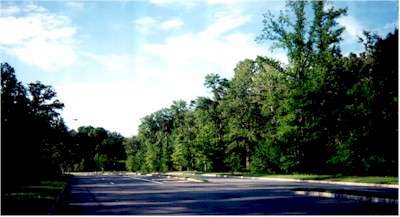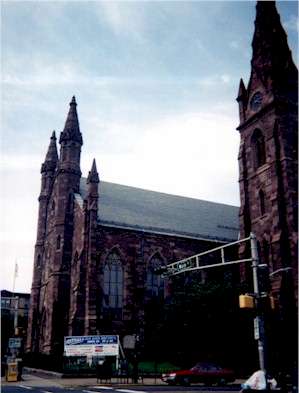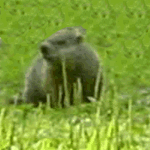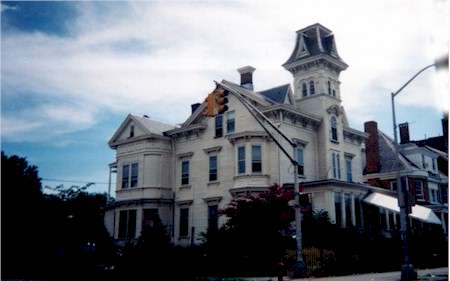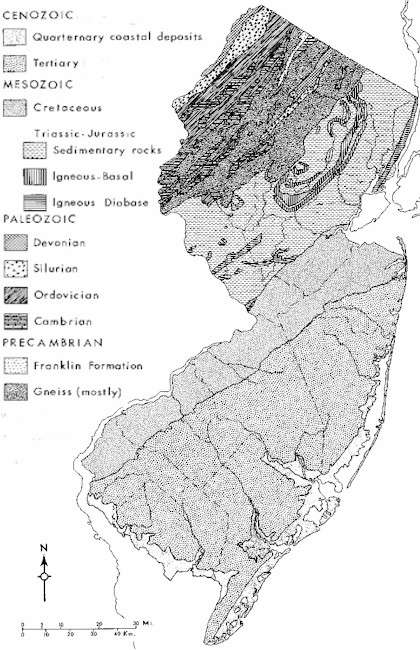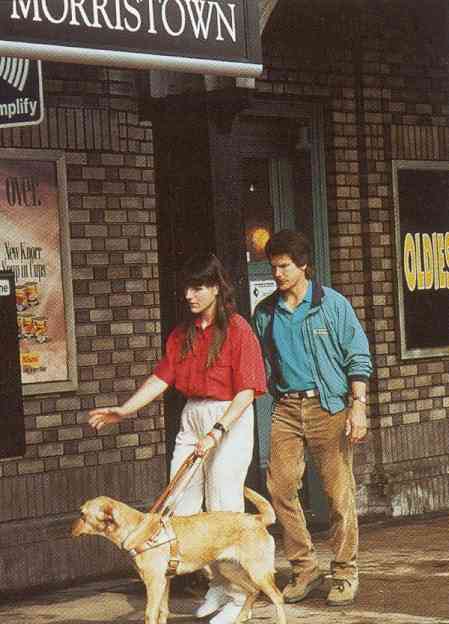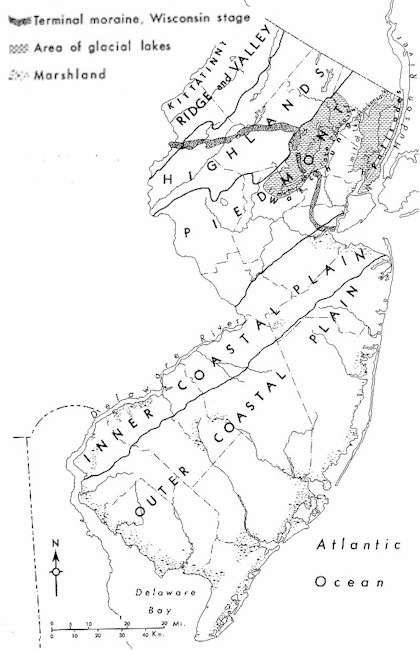People, Freeways, Trees, Geese, Deer
My Impression of New JerseyAlthough New Jersey, ever since her admission into the Union, has been the butt for the sarcasm and wit of those who live outside her borders, - William Cullen Bryant
I expected only freeways and oil storage tanks. There are areas that look like that, but most don't. The whole state seems really just a suburb of either New York (the northern half) or Philadelphia (the southern half). Benjamin Franklin once called New Jersey "a barrel tapped at both ends" for just that reason. It is summer now, hot and muggy (several records for "hottest day ever" have been set this year). This part of the state is based on low-porosity granite which slows the drainage of rain water, making it quite swampy in places (which I had not known) - mosquito heaven. Global warming will probably bring a rise in sea level which could ultimately swallow up about half the state (in the middle) called the "pine barrens" where I've heard a lot of cranberries are grown in the brackish sand. There are more people per square mile in New Jersey (over 1,000) than in any other state in the US (even though half the state is quite sparsely populated - so you can see what's left has LOTS of people). But there're also many older cemeteries and churches, town squares with trees, paths and benches, and frequent advertisements for houses 100 - 200 years old - or even older.
Curiously, there is more wildlife here than anyplace else I've ever seen. Sometimes you'll see a small herd of deer walk between two houses in a residential area. There are groundhogs (also called woodchucks) thicker than armadillos in the streams and sewers, Canadian geese everywhere (you always have to watch where you step because they are very messy) and ducks, squirrels, snapping turtles (huge things that can bite the end off a wooden broom handle), chipmunks, rabbits, nutria - and that's just in the SUBURBS. Mosquitoes are terrible and can carry West Nile virus. Ticks can carry Lyme disease. Poison ivy is ubiquitous and I'm violently allergic to it.
But the whole state is lush with dense greenery (it really IS a "garden state"). The trees are mostly hardwoods and birds of infinite variety can be heard singing almost everywhere. Butterflies flit among the wildflowers. I haven't seen any hummingbirds yet, though I've seen a few feeders. (But it's illegal to feed deer or any water fowl - consequently, the geese are wild, though they are everywhere. If you so much as speak to one, they start hissing and bobbing their heads like they're getting ready to attack. Everyone leaves them ALONE.)
Still, I prefer Wellington. Make that VASTLY prefer.
New Jersey Geology
This shows generalized geology (beneath the soil and subsoil) for the state. Source: A Geography of New Jersey: The City in the Garden - Second Edition by Charles A Stansfield Jr 1998
Morris County HistoryMorris County was created by an act of the state legislature on 15 March 1738, separating it from Hunterdon County. It was named after Colonel Lewis Morris, then the Governor of the Province of New Jersey, and consisted of what are now the counties of Morris, Sussex, and Warren. Known as "The Military Capital of the Revolution," Morris County is rich in historic lore and tradition. During the Revolutionary War, General George Washington and his Continental Army encamped in Morris County during the winters of 1777 and 1779 - 1780, while cannons, shot and powder were manufactured for the troops in furnaces and mills in the area. Benedict Arnold was tried for treason in Morris County, and it was here that the telegraph was perfected and first publicly demonstrated. Morris County is a rare blend of economic strength and a healthy, natural environment. It is estimated more than 450,000 people live in Morris County, located approximately 30 miles northwest of New York City. The county's 39 municipalities cover 469 square miles. Historic Morristown is the county government seat. Morris County GovernmentIn New Jersey, the county serves as the middle layer of government between the federal and state governments and the municipality. The county traces its origin to the British who settled in the "new world" bringing with them the concept of the county as a local unit of government, and the idea that only those who owned land free of any debt, "free-holders," could vote and hold public office. New Jersey is the only state whose elected county representatives are called freeholders. Today, Morris County is governed by a Board of Chosen Freeholders, whose seven members are elected at-large to serve three-year terms. The freeholders derive their broad powers to regulate county property, county finances and county affairs from the state legislature. In Morris County, the freeholder board sets policy for six county departments and more than 30 divisions, plus a number of boards, commissions, authorities, and committees. The actual day-to-day operation of the county government and its departments is supervised by the county administrator, the chief administrative officer of the county. The Board of Freeholders meets on the second and fourth Wednesday of the month at 7:30pm. All meetings are conducted in the Public Meeting Room, 5th floor, Administration and Records Building, Court Street, Morristown. A work session is conducted on the same day as the regular public meeting at 9:30am in the Knox Room, also on the 5th floor of the Administration and Records Building. County Government DepartmentsThere are six departments within the Morris County government. They are:
Morris County government also includes the constitutional offices of the County Clerk, the County Sheriff, the County Surrogate, and the County Prosecutor. Morris County government offers a wide range of services to county residents, from education, transportation, parks and recreation, to social services and nutrition programs for the elderly. For additional information about Morris County government and the services it provides, contact the Public Information Office at (973) 285-6015. Source: Brochure prepared by the Morris County Public Information Office; see also www.co.morris.nj.us
The Seeing Eye, a Morristown Institution
Sit on a park bench in Morristown and you are sure to see blind people walking the streets aided by their Seeing Eye dogs. Both the dogs and the people are in training at The Seeing Eye, Incorporated, which operates just outside of town. The streets of Morristown are a training ground. Guide-dog users and their dogs have to work together for at least three weeks before they become permanent partners. The Seeing Eye, the first guide-dog school in the United States, was established in 1929. Source: New Jersey by R Conrad Stein, 1998 photo courtesy The Seeing Eye seeingeye.org
Friday is the day the dogs-in-training are taken into town to practice. My personal favourites are the setters and retrievers. Some of the dogs don't make it - they are shy, or nervous or get distracted too easily. I want to scoop up each one we pass and hug it but I don't, of course. I don't speak or make eye contact but that's hard. We aren't allowed pets where we are living - this is the first time in my life I haven't owned one. I'd take any one of the dogs we've seen. They are magnificent animals and perform immense services for a lot of people in need - including being dear, constant companions.
Antoine Le Blanc and the Morristown Murdersby Daniel Kupke On 6 September 1883, Antoine Le Blanc was executed for the murder of the Sayre family of Morristown. Le Blanc had been a hand on the Sayre's farm for weeks when one night he called Mr and Mrs Sayre out to the barn where he murdered them with a shovel. He also murdered Phoebe, the Sayre's house servant. In his haste to make off with some of the household valuables, Le Blanc left a trail that let authorities right to him. The townsfolk were not satisfied with the execution, and took an even more gruesome step. Le Blanc's skin was removed from his corpse, and fashioned into purses, wallets, lampshades and book jackets. One of these wallets still exists, and is currently in the possession of the Morristown Museum. The farmhouse where Le Blanc murdered the Sayres has been converted and renovated, and is currently Jimmy's Restaurant. Many customers and employees of the restaurant have reported ghostly phenomena in the building, including changes in temperature, objects being moved, and ghostly reflections in mirrors and windows. Source: The Youngtown Edition 23 October 1992
The reaction of the townsfolk suggests that in that day and age, there were influxes of new people. Those with servants apparently feared vulnerability - being forced to spend isolated periods with relative strangers in an era of no telephone. I would guess it was decided to set a gruesome example so that any servants hearing of Le Blanc's fate would think twice before contemplating something similar. The same ultra-reactions often occurs among the crews of boats at sea. The "ghostly phenomena" in the restaurant are likely motivated by alcohol, mischief or a desire to experience something out-of-the-ordinary. (I would suggest there are better pursuits.)
New Jersey Landforms
Note the northeast-southwest grain of New Jersey's major landforms, with the exception of Source: A Geography of New Jersey: The City in the Garden - Second Edition by Charles A Stansfield Jr 1998
For more articles on New Jersey including facts, census data, complex highway interchanges, photos, transit plans, politicians, geology, canals, regions, governance, flora and
fauna click the "Up" button below to take you to the Table of Contents for this section. |
 Animals
Animals Animation
Animation Art of Playing Cards
Art of Playing Cards Drugs
Drugs Education
Education Environment
Environment Flying
Flying History
History Humour
Humour Immigration
Immigration Info/Tech
Info/Tech Intellectual/Entertaining
Intellectual/Entertaining Lifestyles
Lifestyles Men
Men Money/Politics/Law
Money/Politics/Law New Jersey
New Jersey Odds and Oddities
Odds and Oddities Older & Under
Older & Under Photography
Photography Prisons
Prisons Relationships
Relationships Science
Science Social/Cultural
Social/Cultural Terrorism
Terrorism Wellington
Wellington Working
Working Zero Return Investment
Zero Return Investment